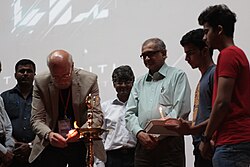Blog Credit: Trupti Thakur
Image Courtesy: Google
NASA’s CHAPEA
It is called “Mars Dune Alpha” and is a 1,700-square-foot building made with 3D printing at the Johnson Space Center in Houston, Texas. It has bedrooms, bathrooms, a work area, a robot station, a gym, and a vertical farm, among other things. It is next to a 1,200-square-foot area that is used to simulate events that would happen outside of vehicles on Mars. The setup includes red, rocky cliffs and simulated Martian dirt to make the experience more real.
Mission Objectives and Experiences
The main reason for this long-term engagement was to collect information on the physical and mental effects of a Mars-like environment, such as being alone, having limited resources, and having to wait for messages to arrive. These new ideas are very important for getting astronauts ready for the mental and physical difficulties of longer-term space missions in the future. Crew members did a wide range of jobs, from simulating spacewalks to growing vegetables. They gave NASA useful information about how to keep people healthy in confined and remote environments.
Participants of the Simulation
Professionals from research scientists to doctors were carefully chosen to be part of the CHAPEA project. Each brought a unique set of skills to the task. Kelly Haston, Anca Selariu, Ross Brockwell, and Nathan Jones were on the crew. They were picked through a tough NASA application process that required them to meet strict health, motivational, and professional standards.
Understanding Mars’ Environment
The climate and landscape of Mars are not suitable for living in. Temperatures change quickly, and the atmosphere is mostly made up of carbon dioxide. It has canyons, volcanoes, and huge dust storms in its scenery. These are some of the things that make manned trips hard. Beyond getting people ready for moral problems on Mars, the mission’s results are meant to help us learn more about the planet so that we can figure out if it has been inhabited in the past and what that means for Earth. Following this first CHAPEA trip, more simulations are planned for 2025 and 2026. The ultimate goal is to send people to Mars by the 2030s.
India’s Involvement in Martian Exploration
Along with NASA’s progress, India’s ISRO has shown a lot of interest in Mars with its successful 2014 Mars Orbiter Mission (MOM). As India’s focus on interplanetary study grows, it has plans for more exploratory missions in the future.
Overview
Four scientists have left a model Mars environment where they lived in isolation for more than a year.
The crew took part in the experiment for the American space agency NASA. Team members included commander Kelly Haston, medical officer Nathan Jones, flight engineer Ross Brockwell and science officer Anca Selariu. They ended their stay after 378 days on July 6.
The simulated Mars environment is called a habitat. NASA said the project “was designed to help scientists, engineers, and mission planners better understand how living on another world could affect human health and performance.”
Officials said the habitat also aimed to recreate certain environmental pressures that future astronauts could face while living in places like the moon and Mars.
The experiment took place inside a specially designed area at NASA’s Johnson Space Center in Houston, Texas. The 160-square-meter environment where the crew members lived was built using 3D printing technology.
The experiment involved the crew completing several research activities. These included taking part in robotic operations, looking after the habitat, doing physical exercise and growing crops. The members also took place in simulated “marswalks.”
The crew members are not NASA astronauts. They left their normal jobs to take part in the experiment. After leaving the habitat, the group was to complete a series of “post-mission data collection activities” over two weeks before returning home.
While inside the environment, NASA said the crew was subject to “Mars-realistic time delays” during communications with the outside world. This meant there could be delays of up to 44 minutes roundtrip for communication data.
In addition, the members had to deal with a limited food system, similar to what astronauts use on the International Space Station (ISS) or during future space deployments.
Commander Haston, a biologist, was the first to speak during a ceremony to mark the mission’s end. “Hello. It’s actually so wonderful just to be able to say hello to you,” she said with a laugh.
Jones – who works as an emergency room doctor – was overcome with emotion after leaving the habitat. “I really hope I don’t cry standing up here in front of all of you,” he said.
Brockwell, a structural engineer, said the experience showed him the importance of living sustainably to help mankind on Earth. “I’m grateful for the chance to live the idea that we must utilize resources no faster than they can be replenished, and produce waste no faster than they can be processed back into resources,” he said.
Selariu, a microbiologist, explained that she had been asked by people many times why humans like her would even want to go to Mars. “Because it’s possible,” she said. “Because space can unite and bring out the best in us.” She added, “Because it’s one defining step that Earthlings will take to light the way into the next centuries.”
The NASA program is officially called the Crew Health and Performance Exploration Analog (CHAPEA). The agency says the latest experiment was the first of three it plans to carry out. The target for the next one will be sometime in 2025.
Steve Koerner is the deputy director of Johnson Space Center. He said most of the experiment centered on nutrition and how that affected the crew’s performance. The work was “crucial science as we prepare to send people on to the red planet.”
Koerner added, “They’ve been separated from their families, placed on a carefully prescribed meal plan and undergone a lot of observation.” He noted that “Mars is our goal,” and called the project an important step in America’s ongoing efforts to be a leader in future world space exploration activities.
Under its Artemis program, NASA plans to send humans back to the moon in order to learn how to live in space for long periods. After that, the goal is to send astronauts to Mars.
I’m Bryan Lynn.
Bryan Lynn wrote this story for VOA Learning English, based on reports from NASA, The Associated Press and Agence France-Presse.
Blog By: Trupti Thakur
15
JulNASA’s CHAPEA
Jul 15, 2024Recent Blog
The TechKritiApr 26, 2025
India’s First Quantum Computing VillageApr 24, 2025
India’s Achievement In QKDApr 22, 2025
The V2G TechnologyApr 21, 2025
Country’s Specific Domain By GoogleApr 19, 2025




